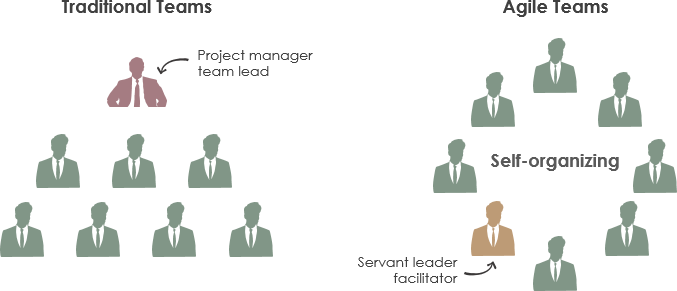Navigating the Agile Landscape: Cross-Functional Teams vs. Self-Organized, Self-Managed Team
Introduction
In today’s rapidly evolving business landscape, Agile methodologies have become the cornerstone of project management and product development. Agile principles and practices offer organizations the flexibility and responsiveness needed to thrive in dynamic markets. One crucial aspect of Agile is team structure, and two prevalent approaches stand out: cross-functional teams and self-organized, self-managed teams. In this exploration, we will delve into the distinctions between these team structures, shedding light on their unique characteristics, advantages, and applications. Join us as we navigate the Agile landscape to better understand how these team configurations impact project success and organizational agility.

Self-organizing teams are a fundamental concept in Agile methodologies, emphasizing autonomy and active participation by team members. Here’s a breakdown of the key points from your statement:
- Autonomy: Self-organizing teams are granted a high degree of autonomy. They are responsible for determining how to accomplish their work and are not directed by external authorities or managers. This autonomy empowers the team members to make decisions about their processes and tasks.
- Choice in Work Approach: Self-organizing teams have the freedom to choose the best approach to accomplish their work. They are not prescribed a specific set of tasks or methods; instead, they collectively decide how to achieve their goals.
- Active Participation: Team members actively participate in all Agile practices and events. This includes activities like sprint planning, daily stand-ups, sprint reviews, and retrospectives. Through active participation, team members collaborate, share information, and collectively make decisions.
- Evolution: Self-organizing teams evolve over time. As team members become more familiar with Agile principles and practices, they learn to work together more effectively, improve their processes, and adapt to changing circumstances. This evolution is a natural outcome of active participation and autonomy.
- Absence of Top-Down Direction: Unlike traditional management approaches where decisions are often made by managers and imposed on the team, self-organizing teams rely on collective decision-making and do not depend on top-down direction or control.
Overall, self-organizing teams are a core component of Agile methodologies, fostering a culture of collaboration, empowerment, and continuous improvement. This approach aligns with Agile principles that emphasize individuals and interactions over processes and tools, and it often leads to more effective and innovative outcomes.

Cross-functional teams vs Self-organized vs Self-managed teams
There are differences between cross-functional teams and self-organized, self-managed teams in the context of Agile methodologies. These two concepts are related but represent distinct aspects of how teams are structured and operate within Agile frameworks like Scrum or Kanban. Here’s an overview of each concept and their differences:
-
Cross-Functional Teams:
- Composition: Cross-functional teams are typically composed of individuals with diverse skills and expertise necessary to complete the work required for a particular project or product increment. This includes members with different technical skills, domain knowledge, and roles (e.g., developers, designers, testers, and business analysts).
- Focus: The main emphasis of cross-functional teams is on ensuring that all the necessary skills and roles are represented within the team to minimize dependencies on external resources or teams. The goal is to have all the expertise needed to deliver a complete product increment or project within the team itself.
- Responsibilities: Cross-functional teams are expected to work together collaboratively to deliver valuable increments of the product. They follow a defined process, often including sprint planning, daily stand-ups, and sprint reviews, to achieve their goals.
-
Self-Organized, Self-Managed Teams:
- Autonomy: Self-organized, self-managed teams have a high degree of autonomy and responsibility. They are empowered to make decisions about how they work, organize their tasks, and collaborate with each other to meet their goals.
- Structure: These teams do not have a predefined structure or hierarchy. Instead, team members collectively decide how to organize themselves, distribute tasks, and address challenges. Leadership and decision-making are often distributed among team members.
- Accountability: Self-organized teams are responsible for setting their own objectives, determining how to achieve them, and continuously improving their processes. They take ownership of their work and are accountable for delivering value to the customer.
While cross-functional teams focus on ensuring that all necessary skills are present within the team, self-organized teams emphasize autonomy and collective decision-making. It’s important to note that these concepts are not mutually exclusive, and Agile teams can incorporate elements of both. For example, a cross-functional team can also be self-organized and self-managed, with team members taking on leadership and decision-making responsibilities themselves.
In practice, Agile organizations may choose to structure their teams based on their specific needs and the nature of their work. The key is to foster a collaborative, adaptive, and customer-focused culture that enables teams to deliver value efficiently and effectively.
Here’s a table that provides a concise contrast between cross-functional teams, self-organized teams, and self-managed teams in the context of Agile:
| Aspect | Cross-Functional Teams | Self-Organized Teams | Self-Managed Teams |
|---|---|---|---|
| Team Composition | Diverse skills and roles | Diverse skills and roles | Diverse skills and roles |
| Autonomy | Moderate | High | High |
| Decision-Making | Team consensus | Team consensus | Team consensus |
| Organizational Structure | Hierarchical | Flat or decentralized | Flat or decentralized |
| Leadership | Traditional roles exist | Shared or distributed | Shared or distributed |
| Accountability | Individual and team-based | Team-based | Team-based |
| Dependency on External Resources | Minimal | Minimal | Minimal |
| Focus | Skill diversity | Autonomy and collaboration | Autonomy and accountability |
| Communication | Structured and formal | Open and informal | Open and informal |
| Process Control | Defined processes | Self-imposed processes | Self-imposed processes |
| Flexibility | Moderate | High | High |
Please note that these are general characteristics, and the actual implementation of these team structures may vary depending on the specific Agile framework, organization, and project requirements. In practice, some teams may blend aspects of these structures to suit their needs, aiming to strike a balance between skill diversity, autonomy, and accountability.
How to Choose?
The choice between cross-functional teams, self-organized teams, and self-managed teams should indeed be related to the maturity of the Agile process within the team and the organization as a whole. The maturity of the Agile process can significantly influence which team structure is most suitable. Here’s how the maturity of the Agile process can impact this decision:
-
Low Agile Maturity:
- Cross-Functional Teams: When an organization or team is just beginning to adopt Agile practices and has a low level of Agile maturity, starting with cross-functional teams can be a sensible choice. Cross-functional teams help ensure that all necessary skills are present within the team, reducing external dependencies and simplifying coordination.
-
Moderate Agile Maturity:
- Self-Organized Teams: As the team gains more experience with Agile methodologies, they may start to transition towards self-organized teams. At this stage, team members are becoming more comfortable with Agile principles and practices, and they can begin taking on more autonomy in organizing their work and making decisions collaboratively.
-
High Agile Maturity:
- Self-Managed Teams: In highly mature Agile organizations or teams, where individuals have a deep understanding of Agile principles and practices, self-managed teams become a viable option. These teams are capable of setting their own objectives, managing their processes, and making critical decisions without the need for extensive external oversight.
It’s essential to assess the Agile maturity of the team and organization and align the choice of team structure with this maturity level. Attempting to implement self-organized or self-managed teams without adequate Agile maturity can lead to challenges and may not yield the desired benefits. Conversely, in highly mature Agile environments, utilizing cross-functional teams might be seen as restrictive.
The choice of team structure should be a deliberate decision that considers the Agile maturity of the team and organization, along with other contextual factors such as the nature of the project and the team’s readiness for increased autonomy and self-management.
Summary
Agile frameworks have revolutionized how teams collaborate and deliver value to customers. Among the numerous components that define Agile success, the choice of team structure plays a pivotal role. In this article, we’ve examined two fundamental approaches: cross-functional teams and self-organized, self-managed teams.
Cross-functional teams bring together individuals with diverse skills, ensuring that all the expertise required for a project resides within the team itself. Their primary focus is on minimizing dependencies on external resources and achieving a holistic understanding of the product or project.
On the other hand, self-organized, self-managed teams embody autonomy and responsibility. These teams are characterized by their ability to make decisions collectively, distribute tasks, and take ownership of their work. They thrive on autonomy and accountability.
Ultimately, the choice between these two team structures depends on the specific needs of the organization, the nature of the project, and the desired level of team autonomy. By understanding the differences and advantages of each approach, organizations can make informed decisions that contribute to their Agile success.

